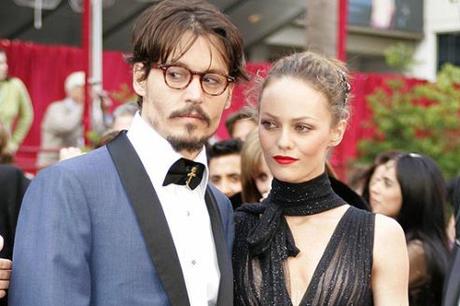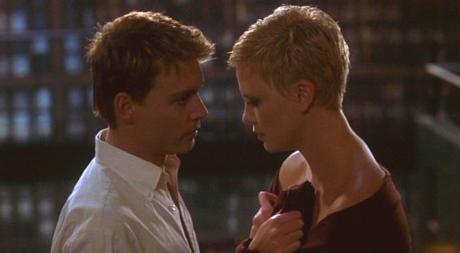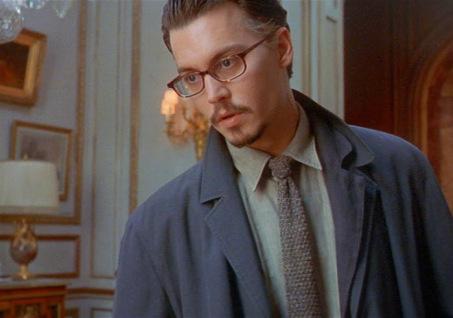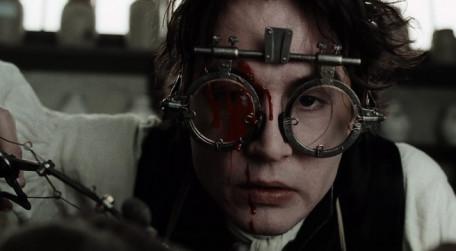 Johnny Depp & Vanessa Paradis (thesun.co.uk)
Johnny Depp & Vanessa Paradis (thesun.co.uk)Adventures in Paradis
Having befriended the trippy gonzo journalist Hunter S. Thompson in real life — and whose funeral expenses he would pay for upon the drug-addled author’s untimely 2005 passing — Johnny Depp continued to push the outside of the envelope as far as it could go with respect to his choice of film roles.
The excitement and anticipation of a new millennium — more specifically, what those expectations might bring in the way of a possible course-change in his career ambitions — were telegraphed in the hugely popular star’s next round of cinematic forays.
Similarly, Johnny’s personal relationships also began to stabilize. Exuding a somewhat calming effect on his high-flying lifestyle, in 1998 the actor met and started a live-in relationship with French-born singer-actress and model Vanessa Chantal Paradis. The product of their 14-year association would result in two new additions to the Depp household: a daughter, Lily-Rose Melody Depp (born in May 1999), and son John “Jack” Christopher Depp III, who was born in April 2002.
Fatherhood and all the customary encumbrances that went with it appeared to suit Depp’s newfound outlook on life quite well, thank you. “Johnny is the perfect father,” Vanessa Paradis would claim in a 2002 Elle magazine article. “He dresses the children, he makes them laugh… [But] he does give Lily-Rose too many potato chips.”
Too many potato chips? She should be so lucky if that’s all there was to complain about, given his notoriety. There’s an unwritten rule that as an actor’s domestic life improves (sometimes, by leaps and bounds) one’s craft tends to suffer along with it. Well … like anything else that concerns the acting profession, we believe there exists some level of “truth” to this parable.
In Johnny’s case, while it may have influenced his performance to a noticeable degree in such family-oriented features as Charlie and the Chocolate Factory and particularly the emotionally draining Finding Neverland, the pictures he participated in before and after he set up shop in the Plan de la Tour region of southeastern France were basically all over the map in terms of story line and character development.

For starters, take the big-budget sci-fi thriller The Astronaut’s Wife from August 1999, written and directed by Rand Ravich and co-starring South African-born actress Charlize Theron. In the picture, Johnny had his hair bleached blond, while Ms. Theron cut hers to resemble Mia Farrow’s crewcut. Talk about a lack of family values, this obviously derivative combination of Roman Polanski’s Rosemary’s Baby (1968) crossed with Taylor Hackford’s The Devil’s Advocate (1997) — to include several ripped-off segments from the Alien saga — was a certifiable bomb at its initial release.
It’s creepy and it’s kooky, and altogether loopy, with both stars giving substandard performances of a slow-moving script hardly worth bothering about. To top it off, the “shock” ending was as lame as they come, something writer-director M. Night Shyamalan might have thought up had he been consulted on the matter.
As Depp’s first in a series of FX-laden, budget-heavy productions, The Astronaut’s Wife took in nowhere near the amount it was expected to make, nor did it earn back what was expended in its making. Did that bit of disappointing box-office news stop Johnny from seeking further challenges along the psychological horror-film front? Not on your life!
A Devil of a Time
As a matter of fact, his next entry would be directed by that old schlockmeister Polanski himself. How’s that for “good” timing? The Ninth Gate (1999), billed as a supernatural mystery thriller, was shot on several European locations in and around France, Spain, and Portugal. Real castles (or châteaux) were used as backdrops for many of the outdoor scenes.

Despite the exotic locales Johnny played it straight throughout, remaining calm, cool and collected, and properly subdued much to producer-director Polanski’s annoyance. Depp’s character, Dean Corso, was supposed to be a New York rare-book dealer and part-time con artist. So how would it look if the guy went off the deep end every time a wealthy client approached him about retrieving some long-lost copy of an ancient relic, including one purportedly written by Beelzebub?
Along with Depp, former leading man-turned-character actor Frank Langella was hired for the part of the myopic Boris Balkan, an all-too-visibly obsessed collector of rare books. Lena Olin played a rich widow named Liana Telfer, with James Russo as Bernie Rothstein and Barbara Jefford in strong support as the Baroness Kessler. The director’s main squeeze and current wife, Emmanuelle Seigner (Frantic, Bitter Moon), was mysteriously billed as “The Girl” Johnny has sex with outside one of those spooky-looking castles. Hmm …
The movie starts off well, with a convincing atmosphere of dread and gloom pervading the action, sets, and color palette, ideally provided by cinematographer Darius Khondji (Se7en). Polish composer Wojciech Kilar’s groaning, eerie-sounding film score, suggestive of the excellent one he did for Bram Stoker’s Dracula, helps to maintain the unsettling mood.
Soon, however, we are introduced to what Village Voice critic J. Hoberman termed “barely releasable hokum, stuffed with cheesy blah-blah” via satanic devil-worship and all sorts of occult-like mumbo-jumbo. This is where things start to unravel, especially towards the end. The late Chicago Tribune movie critic Roger Ebert’s crack about the “fade-to-white” finish holds especially true.
Still, this was the spot where Johnny got to meet and greet Ms. Paradis, so it wasn’t a total loss (if you get my drift). In the future, he could work closer to home as well as be near his growing brood and sprawling two-million-dollar estate.
Career-wise, most reviewers agreed that Depp had performed well under Mr. Polanski’s direction, despite so-called “creative differences.” He even sported patches of graying hair on both sides of his temples to portray the 40-something Corso. Now THAT’S acting, folks, or at the least total role immersion.
Way to go, Jack!
This is Halloween
Or maybe we should change that to Jack-o’-Lantern in deference to his next project, Sleepy Hollow, also from 1999. Directed by Tim Burton, with a screenplay by Andrew Kevin Walker and a powerful organ-based score by frequent Burton collaborator Danny Elfman (who also did the music for Burton and Depp’s Edward Scissorhands), this screen adaptation of Washington Irving’s short story, The Legend of Sleepy Hollow, was a direct homage to Britain’s Hammer Studios and their blood-stained output of the late 1950s to 1960s.
Hammer Studios, you may recall, was renowned for their recreation of those time-honored Universal monster classics Dracula, Frankenstein, the Wolf Man, and the Mummy, in addition to side trips involving Dr. Jekyll and Mr. Hyde. The difference lay, however, in their full-color splatter effects, oozing guck from open wounds, and Victorian ladies’ tight bustiers bursting to overflowing. Sex, blood and gore: that’s the ticket!
A thorough reimagining of Irving’s tale, this newest version of the Sleepy Hollow yarn (a place this writer once visited as a boy, and which cartoonist Walt Disney had the utmost pleasure in animating) was filmed in Merry Olde England, naturally. Production values and craftsmanship, along with small-town village ambiance, were said to recapture the spirit and essence if not the literal letter of the story better than the real Tarrytown, in spite of numerous deviations in the script.
Depp was signed on to play the sniveling, snipe-nosed pedagogue Ichabod Crane. Proving far too handsome to embody Ichabod as the original author had conceived him, Depp and Burton hit upon the novel idea of transforming the character into a New York City police inspector who employs the most “modern” of scientific techniques to track down and capture the killer who’s been lopping off the heads of the helpless citizens of the titular town.

Deemed too “prim and proper” by some reviewers, Depp nevertheless excelled as a colonial Sherlock Homes-type who wades far too deeply into Sleepy Hollow’s tawdry familial ties for his own good. It’s been rumored that Johnny modeled his finicky, nerve-wracked portrayal of Constable Crane on the shakiness of former child actor Roddy McDowall, to include some of his vocal inflections.
“I always thought of Ichabod as a very delicate, fragile person,” Johnny confided to the supermarket tabloid Entertainment Weekly, “who was maybe a little too in touch with his feminine side, like a frightened little girl.” This would account for Ichabod’s frequent fainting spells at the slightest provocation. Johnny’s particular gift was in making this coward into a sympathetic, albeit clownish adversary.
The washed-out, monochromatic color scheme and hazy look of the picture was credited to Mexican cinematographer Emmanuel Lubezki, who was feted in February 2016 with a third Academy Award for his back-to-back efforts (i.e., Gravity, Birdman, and The Revenant) for director Alejandro González Iñárritu. The visual FX by Industrial Light & Magic (ILM) and the Headless Horseman green-screen effects by Kevin Yagher (story credit), complemented by Rick Heinrichs and Peter Young’s Oscar®-winning production designs and Colleen Atwood’s superb period costumes, came together to make this a meaningful endeavor.
Although Johnny was the obvious star of the proceedings, the cast assembled for the outing read like a who’s-who of Hollywood’s finest supporting players: from Michael Gambon as Van Tassel, Miranda Richardson as Lady Van Tassel, the always dependable Jeffrey Jones (along with Heinrichs, a Burton regular) as the periwig-wearing Reverend Steenwyck, Richard Griffiths as Magistrate Philipse, and a slimy Ian McDiarmid as Dr. Lancaster, to the dyspeptic Michael Gough as Notary Hardenbrook.
There were brief bits by octogenarian Christopher Lee (a Hammer Studios alumnus), Alun Armstrong, Martin Landau (unbilled), Lisa Marie, and Christopher Walken as a pointy-toothed Headless Horseman (doubled by stuntman Ray Park). Among such lofty company, only a far too low-key Christina Ricci failed to impress as Katrina Van Tassel.

With deft ensemble work, credit must also go to casting directors Susie Figgis and Ilene Starger for assembling such a uniformly excellent company of players. And let us not forget the more junior members of the group, including the adorably dimpled, dark-haired Sam Fior as Young Ichabod, Marc Pickering as Young Masbath, Tessa Allen-Ridge as Young Lady Van Tassel, and Cassandra Farndale as the Young Crone.
Burton upped the ante on the blood and gore quotient to rival the best horror that Hammer had to offer. What that studio once lacked and that he and Johnny introduced into Sleepy Hollow was a good deal of black humor that made the horrendous portions more (gulp!) … digestible. There were even touches of Edward Scissorhands in Crane and Katrina’s blossoming relationship (on and off-screen, so we are told). The ghoulish Grand Guignol aspects would reassert themselves a few years later in Burton and Depp’s 2007 interpretation of Sondheim’s Sweeney Todd.
(To be continued…)
Copyright © 2016 by Josmar F. Lopes

